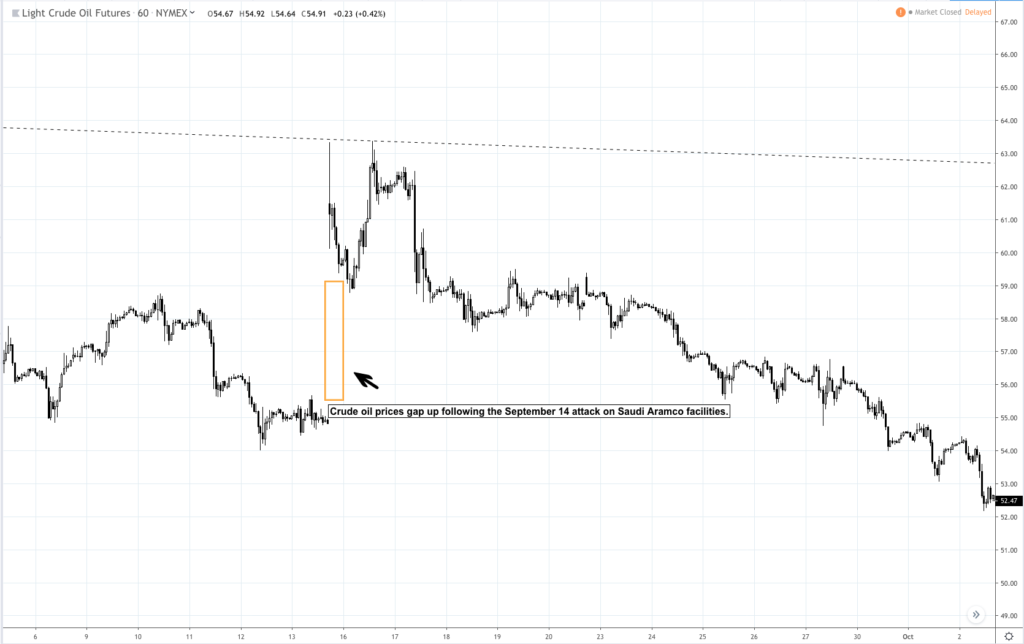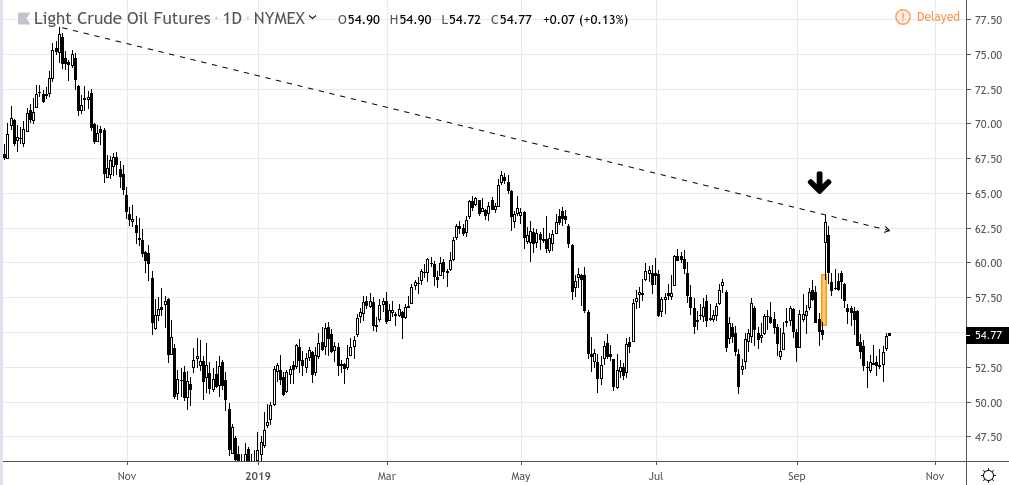In the futures industry, news drives the markets. Sometimes traders are able to anticipate upcoming news as is the case with news reports; at other times, the news can be completely unexpected and can totally shock the market. These shocks can be positive or negative, to which follows volatility that can favor or plunge markets. Sometimes these shocks herald situations that may continue in the direction of the initial news, but often they can cause over-reactions in the markets.
Recently, the crude oil markets underwent an entirely unexpected shock when military drones attacked Saudi Arabia’s state-owned Saudi Aramcos.
The Event
On September 14, 2019, (it was estimated that) ten drones in addition to a few cruise missile attacks bombed Saudi Aramco oil processing facilities.
Potential Significance
Saudi Arabia is the world’s largest oil exporter, according to a Reuters report. In 2017, Saudi Arabia produced roughly 12 million barrels of petroleum products a day. The attack knocked out an estimated 5% of the world’s oil supply. Following the attack, Saudi Arabia shut down half of its oil production but its energy minister said that the kingdom can draw from its reserves to compensate for the loss in production.
Market Response
The drone attack occurred on Saturday, September 14 while the markets were closed. On Friday, September 13, crude oil had closed at 54.82. When the Globex crude oil market opened on Sunday, September 15, the price gapped up, opening at 61.48 (as shown in the figure below).
Crude Oil (CL continuous contract) – 1-Hour Chart – September 5 to October 3, 2019

Crude oil topped out at 63.34 on September 15 and 16, after which it continued its downtrend. The image below provides a wider picture of the trend.
Crude Oil (CL continuous contract) – 1-Hour Chart – September 11, 2018 to October 11, 2019

Technical traders who went long crude oil thinking that the attack would disrupt global oil supply on a longer-term basis might have interpreted the near-term swing high of 66.60 as a critical level indicative of a major shift in the overall market trend.
Price never broke through that critical resistance point. Among the major reasons for this lack of bullish price support is the global economic environment overall. On September 3, US manufacturing data came in weak, indicating slowing growth in the global economy. A weakening global economy typically indicates less of a demand for crude oil.
Despite the headline shock that took crude oil prices up for a few days, the bigger picture indicates there is likely a weakening demand for crude oil. In this case, it appears that the larger macro fundamental trend ultimately absorbed the price shocks, normalizing the price to an appropriate level.
The Bottom Line
The gap in crude oil prices on September 15 exemplifies a price shock that might have been faded, or that might have served as a strong “short” entry point. Considering the larger fundamental context–data supporting the idea of global economic slowing—savvy traders might have anticipated (correctly so) that this price shock would soon be followed by a correction, as it would be unlikely that crude oil prices were about to reverse given the current economic factors driving the price of oil. With that said, it’s always best to understand the fundamental context prior to entering a “technical” trade.
Please be aware that the content of this blog is based upon the opinions and research of GFF Brokers and its staff and should not be treated as trade recommendations. There is a substantial risk of loss in trading futures, options and forex. Past performance is not necessarily indicative of future results.
Disclaimer Regarding Hypothetical Performance Results: HYPOTHETICAL PERFORMANCE RESULTS HAVE MANY INHERENT LIMITATIONS, SOME OF WHICH ARE DESCRIBED BELOW. NO REPRESENTATION IS BEING MADE THAT ANY ACCOUNT WILL OR IS LIKELY TO ACHIEVE PROFITS OR LOSSES SIMILAR TO THOSE SHOWN. IN FACT, THERE ARE FREQUENTLY SHARP DIFFERENCES BETWEEN HYPOTHETICAL PERFORMANCE RESULTS AND THE ACTUAL RESULTS SUBSEQUENTLY ACHIEVED BY ANY PARTICULAR TRADING PROGRAM.
ONE OF THE LIMITATIONS OF HYPOTHETICAL PERFORMANCE RESULTS IS THAT THEY ARE GENERALLY PREPARED WITH THE BENEFIT OF HINDSIGHT. IN ADDITION, HYPOTHETICAL TRADING DOES NOT INVOLVE FINANCIAL RISK, AND NO HYPOTHETICAL TRADING RECORD CAN COMPLETELY ACCOUNT FOR THE IMPACT OF FINANCIAL RISK IN ACTUAL TRADING. FOR EXAMPLE, THE ABILITY TO WITHSTAND LOSSES OR TO ADHERE TO A PARTICULAR TRADING PROGRAM IN SPITE OF TRADING LOSSES ARE MATERIAL POINTS WHICH CAN ALSO ADVERSELY AFFECT ACTUAL TRADING RESULTS. THERE ARE NUMEROUS OTHER FACTORS RELATED TO THE MARKETS IN GENERAL OR TO THE IMPLEMENTATION OF ANY SPECIFIC TRADING PROGRAM WHICH CANNOT BE FULLY ACCOUNTED FOR IN THE PREPARATION OF HYPOTHETICAL PERFORMANCE RESULTS AND ALL OF WHICH CAN ADVERSELY AFFECT ACTUAL TRADING RESULTS.